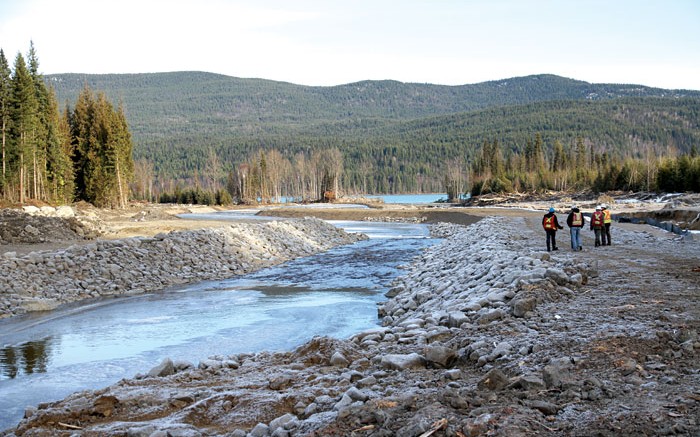VANCOUVER — After 16 months of deliberation, B.C.’s chief mine inspector has concluded that Imperial Metals (TSX: III; US-OTC: IPMLF) will not be held liable for the catastrophic failure of its Mount Polley gold and copper tailings dam and storage facility, 56 km northwest of Williams Lake, B.C.
The investigative report states that the dam failed because the design of the original facility and subsequent raises did not consider the strength and location of an underlying clay unit.
However, this crucial geotechnical oversight did not contravene any existing mining laws, according to the B.C. Ministry of Energy and Mines.
In a press release, the ministry did comment that the company exercised “weak practices” during the mines’ operation, but there wasn’t enough evidence to warrant further investigation and penalty.
“We conducted a thorough and in-depth examination … from its initial site investigations 26 years ago to present,” Al Hoffman, the mine’s chief inspector, said in the release. “We determined that while the mine did not contravene any existing regulatory requirements, its management and operation practices failed in a number of areas, such as water management and misplaced confidence in the tailings site facility design.”
The dam failed in August 2014 when a clay layer in its foundation slipped without warning, and 25 million cubic metres of mine waste and water spilled through a massive breach in the dam and into a nearby stream and lake.
Investigations into the incident found that there was “too much” water in the tailings facility at the time of the breach, which had exacerbated the dam’s collapse.
“[The company] failed to effectively manage water at the mine site and in the tailings site facility … and did not adequately characterize the risk of surplus supernatant water, which had been compounding since the mine reopened in 2005,” the release stated.
Steve Robertson, vice-president of corporate affairs for Imperial, told The Northern Miner during a phone interview that his company is pleased the chief inspector ruled that the cause of the failure “was the mistake in the engineering work done, [but] we were disappointed that their perspective centered on our water management.
“The reason we had too much water wasn’t because we didn’t understand the water balance — we knew there would be an increasing surplus during the life of the project, and we were proactive in seeking the necessary permits to discharge it,” he added.
According to the inspector’s report, Imperial had applied for a water discharge permit in 2006, but for “unknown reasons,” it wasn’t accepted by the Ministry of Environment until six years later, in 2012.
The report states that “the chief inspector did not determine the root causes for the duration of this permit process. However, regardless of the cause(s), the time delay in completing the permitting process was identified as a contributing factor in the proximate cause of surplus supernatant water.”
Meanwhile, the long-awaited permit had its limitations — it let Imperial release 1.4 million cubic metres, provided the water quality and flow rates into Hazeltine Creek were acceptable.
Under the set of conditions, Imperial couldn’t discharge enough to ease the surplus, so it began amendment with the Ministry to approve higher discharge.
The permit was amended in July 2014, one month before the breach occurred.
“The real irony in all of this is that the water quality at Mount Polley is excellent,” Robertson said. “Since we couldn’t discharge, we’ve continually recirculated water through our tailings and plant for 17 years. Despite being in continual contact with ore, waste and tailings, the water only has two elements — copper and selenium — that were slightly off spec for drinking water. That really gives you a good idea about how clean this water is.”
After spending over $65 million in remediation work to clean up the site, Imperial was granted permission to temporarily reinstate operations at Mount Polley in June 2015, provided that any waste generated would be placed in the Springer Pit.
Robertson said that under the amended permit, any water at the tailings facility from natural precipitation is also diverted to the pit.
“This is the first time we’ve had a permit that allowed us to properly manage our water balance at-site,” he added. “Another important lesson to be learned … is that any delay in issuing permits creates an even greater risk to the environment, local communities and to the operation.”
The 16-month long investigation has been deemed the largest and most complex investigation and analysis ever done in B.C., and 19 recommendations were made to ensure that similar collapses do not occur again.
These recommendations include that a dam safety manager be designated at mine sites, along with creating an enforcement team within the ministry, helmed by a new deputy chief inspector of mines.
For Robertson, a big value-add is that mines in BC are likely to be required to have an independent engineering review panel to help investigate tailings facilities.
“To have a senior group of engineers and scientists overseeing and looking for pitfalls is going to be a big improvement over the previous system,” Robertson said. “It will provide the company, public and the government more confidence in the construction and operation of a tailings facility.”
Mining companies need to retain an engineer of record to oversee tailing compounds.
These professionals are governed by the Association of Professional Engineers and Geoscientists of B.C. (APEGBC) — the licensing and regulatory body charged with protecting public safety in the province.
But according to the chief inspector’s findings, there were no guidelines or regulatory requirements in place for foundation investigations. APEGBC will release the obligations to its members early this year.
In the meantime, Robertson said Imperial is driving Mount Polley back to full operation.
“We anticipate that the statutory decision on our permits for resuming full-time operations will be in April,” he said, noting that the company will submit a long-term water management plan to the ministry by June 2016. “We definitely won’t use the Springer Pit for long-term, and although we’re investigating other ways to deal with our tailings, the work we’ve done so far points to the use of our existing facility.”
The British Columbia Conservation Officer Service (COS) is still investigating the Mount Polley incident, based on compliance with the Ministry of Environment’s legislation. If the COS finds Imperial in non-compliance, the company could face prosecution.




I wonder how much the judge was paid for this decision??????
it must carry on, so more gold bricks can be stacked in a vault somewhere. Rich greedy fools.